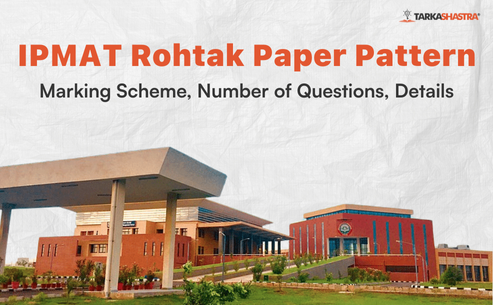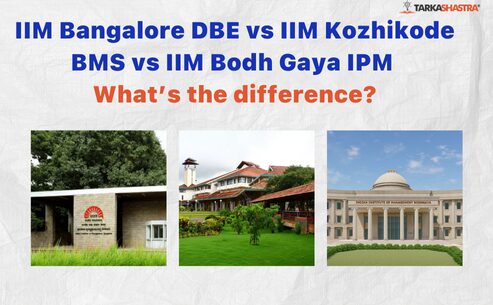Why Understanding the IPMAT Rohtak Paper Pattern is Crucial
The Integrated Programme in Management Aptitude Test (IPMAT) Rohtak 2026 is the gateway for students aspiring to join the prestigious 5-Year IPM program offered by IIM Rohtak. As one of India’s top B-schools, IIM Rohtak provides a direct pathway into management education after Class 12—without the need to take the CAT or pursue a separate postgraduate degree later.
But cracking this exam is no cakewalk.
With over 14,000 students competing for a limited number of seats every year, an innovative preparation strategy is non-negotiable. And that begins with understanding the paper pattern inside out.
Whether you’re a student preparing for the 2026 attempt or a parent helping plan the study roadmap, the IPMAT Rohtak exam format plays a decisive role in how you study, how you practice, and how you score.
Let’s take a quick look at what makes the IPMAT Rohtak 2026 structure unique:
| Element | Details |
| Mode of Exam | Online (Computer-Based Test) |
| Duration | 120 minutes (2 hours) |
| Total Questions | 120 questions |
| Sections | 3 – Quantitative Ability, Logical Reasoning, Verbal Ability |
| Question Type | All Multiple Choice Questions (MCQs) |
| Marking Scheme | +4 for correct, -1 for incorrect answers |
| Sectional Timing | No sectional time limit |
| Negative Marking | Yes (Uniform across all sections) |
This paper pattern isn’t just a list of facts—it directly affects your exam strategy, timing, accuracy, and attempt pattern.
In the following sections, we will break down each component of the IPMAT Rohtak paper pattern 2026—from the marking scheme to section-wise question distribution—so you can confidently build your preparation plan.
Quick Overview of IPMAT Rohtak 2026
Before diving into the nitty-gritty of question types and section-wise strategies, it’s essential to get a bird’s-eye view of what the IPMAT Rohtak 2026 exam entails.
The IPMAT is not just a test of aptitude—it’s a test of balance, where your logical thinking, mathematical foundation, and verbal clarity are evaluated equally. Understanding the structure beforehand helps you prioritize your strengths and improve weak areas early on.
Here’s a quick summary of the exam structure:
IPMAT Rohtak 2026 – At a Glance
| Feature | Description |
| Conducting Body | Indian Institute of Management (IIM) Rohtak |
| Exam Name | IPMAT Rohtak (Integrated Program in Management Aptitude Test) |
| Exam Level | National (for Class 12 appearing/passed students) |
| Mode of Exam | Online – Computer-Based Test (CBT) |
| Duration | 120 minutes (2 hours) |
| Total Sections | 3 – Quantitative Ability, Logical Reasoning, Verbal Ability |
| Total Questions | 120 questions (40 per section) |
| Type of Questions | All MCQs (Multiple Choice Questions) |
| Total Marks | 480 marks |
| Marking Scheme | +4 for correct answer, -1 for incorrect answer |
| Sectional Time Limit | None (students can switch between sections freely) |
| Sectional Cut-Offs | Not applicable (overall score is considered for shortlisting) |
| Language of Paper | English |
Key Highlights:
- Unlike IPMAT Indore, Rohtak does not include Short Answer (SA) questions.
- There are no sectional cut-offs, but balanced performance is essential.
- All questions are objective MCQs with uniform weightage.
- Negative marking applies to every incorrect answer, across all sections.
Understanding this structure early in your preparation helps you:
- Simulate realistic mocks
- Allocate time strategically
- Prioritize topics based on scoring potential
In the next section, we’ll break down the exam structure section-wise—including the number of questions, time management tips, and marking scheme for each.
IPMAT Rohtak 2026 Exam Structure: Section-Wise Breakdown
The IPMAT Rohtak 2026 paper is divided into three equally important sections, each designed to test a different aspect of your aptitude:
- Quantitative Ability (QA) – Your command over numbers, logic, and calculations
- Logical Reasoning (LR) – Your ability to analyze, deduce, and think critically
- Verbal Ability (VA) – Your comprehension, grammar, and communication skills
Let’s break down the section-wise structure in detail.
Section-Wise Format of IPMAT Rohtak 2026
| Section | No. of Questions | Type of Questions | Suggested Time | Marking Scheme |
| Quantitative Ability (QA) | 40 | MCQs | ~40 mins | +4 for correct, -1 for incorrect |
| Logical Reasoning (LR) | 40 | MCQs | ~40 mins | +4 for correct, -1 for incorrect |
| Verbal Ability (VA) | 40 | MCQs | ~40 mins | +4 for correct, -1 for incorrect |
| Total | 120 | — | 120 mins | 480 marks total |
- All sections are equally weighted.
- You can attempt questions in any order. No time limit per section.
- There is no sectional cut-off—only the total score matters.
What Does This Mean for You?
- Equal importance across all sections: You cannot ignore any one section, as all contribute equally to the final score.
- Strategic flexibility: You can start with your strongest section to build momentum.
- Time management is key: While there’s no hard limit per section, spending too long on QA might leave you with less time for VA or LR.
- Accuracy matters: With negative marking of -1, wild guesses can lower your score.
Pro Tip from Tarkashastra:
Treat each mock test like the real exam—attempt 40 questions per section within 40 minutes. This simulates the exam day pressure and helps build muscle memory for speed and accuracy.
In the next section, we’ll dive into the marking scheme in more detail and explore how your score is calculated—and penalized.
Detailed Marking Scheme for IPMAT Rohtak 2026
Understanding the marking scheme is not just about how many marks you get for a correct answer—it’s also about how much you can lose for a wrong one. In a highly competitive exam like IPMAT Rohtak, every single mark matters, and the difference between making it to the PI shortlist or missing it can be as minor as 2–3 marks.
Let’s decode how your final score is calculated.
Official Marking Scheme of IPMAT Rohtak 2026
| Action | Marks Awarded |
| Correct Answer | +4 marks |
| Incorrect Answer | –1 mark |
| Unattempted Question | 0 marks |
Important Points to Remember
- Uniform Marking Across Sections: Whether it’s Quantitative Ability, Logical Reasoning, or Verbal Ability—every question follows the same +4 / –1 format.
- Negative Marking Applies Everywhere: This means even in Verbal Ability and Logical Reasoning, careless guessing can cost you.
- No Partial Marking: You either get the complete +4 or lose 1 mark for a wrong answer. There’s no in-between.
- All Questions Are MCQs: There are no Short Answer (SA) or subjective components like in IPMAT Indore.
Score Calculation Example
Let’s say you attempted 100 out of 120 questions, and here’s your breakdown:
| Outcome | Number of Questions | Score Contribution |
| Correct | 70 | 70 × 4 = 280 |
| Incorrect | 30 | 30 × (–1) = –30 |
| Unattempted | 20 | 0 × 0 = 0 |
| Total Score | — | 250 / 480 |
What Does This Mean for Your Strategy?
- Aim for 80–90% accuracy: It’s better to attempt 85 questions with high precision than 110 with careless errors.
- Use clever elimination techniques to reduce guesswork and increase confidence per attempt.
- Practice mock-based simulations to balance speed and accuracy under real exam pressure.
In the next section, we’ll highlight the unique features of IPMAT Rohtak’s paper pattern that distinguish it from other entrance exams—including IPMAT Indore.
Key Features of IPMAT Rohtak Exam Pattern
The IPMAT Rohtak exam may seem straightforward at first glance—but it hides some critical structural features that can make or break your preparation strategy. Knowing these features in detail helps you optimize time, focus on high-impact sections, and avoid common pitfalls.
Let’s explore what sets IPMAT Rohtak apart.
Top Highlights of the IPMAT Rohtak 2026 Pattern
| Feature | Details |
| All MCQ-Based | No Short Answer (SA) questions—unlike IPMAT Indore |
| Equal Weightage | 40 questions per section × 3 = 120 questions; 160 marks per section |
| No Sectional Time Limit | You can switch between sections freely during the 120-minute window |
| No Sectional Cut-Offs | Only total score matters for shortlisting |
| Negative Marking in All Sections | Every incorrect answer deducts 1 mark across all sections |
| Logical Reasoning Section | Present only in IPMAT Rohtak (not part of Indore’s test) |
| Online Mode Only | Computer-Based Test conducted at designated centers |
| Standard Class 6–10 Syllabus | Questions are based on concepts from middle to secondary school |
Why These Features Matter to Aspirants
- Balanced Preparation is Crucial
Since every section carries equal weightage, ignoring even one section (like VA or LR) can drastically hurt your total score.
- No Sectional Cut-Off = Strategic Flexibility
You can play to your strengths. For example, if you’re strong in Verbal and Logical but average in Quant, you can still score competitively by maximizing in those two.
- Time Management Becomes Your X-Factor
With no sectional time caps, it’s your responsibility to distribute the 120 minutes wisely—based on strengths, weaknesses, and question difficulty.
- MCQ-Only Format Means No Guesswork Advantage
Unlike SA-type questions (which don’t penalize you), Rohtak’s MCQ-only format means poor accuracy can severely impact your score.
Comparison Snapshot
Here’s a visual comparison between Rohtak and Indore:
| Feature | IPMAT Rohtak | IPMAT Indore |
| Logical Reasoning | ✅ Included | ❌ Not included |
| Short Answer (SA) | ❌ Not present | ✅ Included |
| Sectional Cut-Offs | ❌ No | ✅ Yes |
| Sectional Time Limit | ❌ No | ✅ Yes (40 min each) |
| Exam Structure | 3 Sections × 40 MCQs | QA-MCQ, QA-SA, VA |
| Exam Level | Class 6–10 aptitude | Class 11–12 Quant + RC |
Understanding these key features allows you to go beyond just “solving questions.” You begin to solve strategically, which is the difference between clearing the cut-off and cracking the top percentile.
In the next section, we’ll deep dive into the topic-wise syllabus of each section so you know exactly what to prepare.
IPMAT Rohtak 2026: Topic-Wise Coverage in Each Section
The IPMAT Rohtak exam tests aptitude, logic, and language comprehension—but the real challenge lies in the breadth of topics across these three areas. While the questions are based on the Class 6–10 level, the framing and time pressure require bright conceptual clarity and fast application.
Below is a section-wise topic breakdown to guide your preparation plan effectively.
A. Quantitative Ability (QA)
The Quantitative Ability section of IPMAT Rohtak 2026 is designed to assess a candidate’s numerical aptitude, mathematical reasoning, and calculation accuracy. With 40 MCQs to be solved in 40 minutes, the section requires both speed and conceptual clarity.
Unlike board exams that reward stepwise solving, IPMAT expects you to cut through problems efficiently — often under pressure. So, knowing which topics matter can save both time and effort.
Topics Covered in Quantitative Ability
| Topic | Key Concepts/Subtopics |
| Number System | LCM & HCF, divisibility rules, remainders, base systems, cyclicity |
| Arithmetic | Percentages, Profit & Loss, Simple & Compound Interest, Ratio & Proportion |
| Averages & Mixtures | Weighted averages, Alligation rule |
| Algebra | Linear & Quadratic Equations, Algebraic Identities, Inequalities |
| Geometry & Mensuration | Triangles, Circles, Polygons, Areas, Volumes, 2D/3D Geometry |
| Time, Speed & Distance | Relative speed, Boats & Streams, Trains |
| Time & Work | Work-Efficiency, Pipes & Cisterns |
| Data Interpretation | Tables, Bar Graphs, Line Graphs, Pie Charts (Basic DI problems) |
| Permutation & Combination | Factorials, Counting Principles, Basic Arrangements |
| Probability | Simple events, coin/dice problems, card-based scenarios |
| Set Theory | Venn Diagrams, Union-Intersection |
| Sequences & Series | Arithmetic Progression (AP), Geometric Progression (GP), Sum of n terms |
| Logarithms & Indices | Laws of Logs, Simplification, Surds & Indices |
Key Preparation Tips
- Foundation first: Build concepts using NCERT Class 9–11 books before jumping into advanced material.
- Mock practice: Take topic-wise timed quizzes to build speed.
- Shortcuts matter: Learn tricks for percentages, ratios, and averages to save time during calculation.
- DI is scoring: Practice reading data charts quickly and accurately.
Estimated Topic-Wise Weightage (Past Trends)
| Topic | Number of Questions |
| Venn Diagram | 2 |
| Boats & Streams | 2 |
| Train | 1 |
| Simple Interest / Compound Interest | 4 |
| Percentages | 2–3 |
| Profit & Loss | 1–2 |
| Mixture & Allegations | 1–2 |
| Ratio | 1–2 |
| Ages | 1 |
| Permutation & Combination, Probability | 2 |
| Geometry & Mensuration | 3 |
| Pipe & Cistern | 1 |
| Basic Algebra | 1–2 |
| Calendar | 1 |
| Coordinate Geometry | 2 |
| Number System | 1 |
| Average | 2–3 |
Note: The exact number of questions may vary each year, but the distribution gives you a strategic prep direction.
B. Logical Reasoning (LR)
The Logical Reasoning section in IPMAT Rohtak 2026 evaluates a candidate’s analytical ability, decision-making skills, and pattern recognition. It consists of 40 MCQs to be attempted in 40 minutes, making it a high-speed, high-focus section.
Unlike Quant, LR doesn’t rely on formulas — instead, it rewards structured thinking and mental agility. Regular practice is the only way to master this section.
Topics Covered in Logical Reasoning
| Topic | Key Concepts / Subtypes |
| Series & Patterns | Number series, alphabet series, odd-one-out, pattern continuation |
| Coding-Decoding | Letter coding, symbol coding, numerical coding |
| Blood Relations | Puzzle-based and direct relation-based questions |
| Direction Sense | Compass-based logic, distance/direction determination |
| Syllogisms | Venn diagram method, analytical conclusions |
| Seating Arrangements | Linear and circular arrangements, with or without conditions |
| Puzzles | Family trees, comparisons, sequencing problems |
| Data Sufficiency | One-statement/two-statement sufficiency for decision-making |
| Logical Deductions | Statement-conclusion, statement-assumption, cause-effect |
| Input-Output | Machine-based reasoning questions (rare but asked occasionally) |
| Clocks & Calendars | Basic formula-based time and date logic |
| Ranking & Order | Position-based logic, age ranking, tallest-shortest type questions |
Key Preparation Tips
- Start with the basics: Strengthen the fundamentals of patterns, puzzles, and sequences.
- Practice daily: 2–3 LR sets a day can significantly boost accuracy and familiarity.
- Visual aids: Use tables, flowcharts, and diagrams to decode seating, puzzles, and family trees.
- Avoid assumptions: Stick to what’s given — Logical Reasoning is about inference, not intuition.
Estimated Topic-Wise Weightage (Past Trends)
| Topic | Number of Questions |
| Direction Test | 3 |
| Coding-Decoding | 3 |
| Circular Sitting Arrangement | 5 |
| Linear Arrangement | 2 |
| Number Series | 1 |
| Blood Relation | 1 |
| Cube | 1 |
| Dice | 1 |
| Critical Reasoning (CR) | 2 |
| Data Sufficiency | 2 |
| Comparison-Based Arrangement | 2 |
Tip: LR is highly scoring once you crack the pattern — invest time early to reap the rewards later.
C. Verbal Ability (VA)
The Verbal Ability section of IPMAT Rohtak 2026 tests your English language comprehension, grammar accuracy, vocabulary depth, and logical structuring of ideas. With 40 MCQs to be solved in 40 minutes, this section can be a strong scoring area — provided you have a habit of reading and a grasp of the rules.
This section does not involve heavy memorization but focuses on your ability to understand, interpret, and apply language logically.
Topics Covered in Verbal Ability
| Topic | Key Concepts / Subtypes |
| Reading Comprehension | Inference-based, factual, tone & theme questions, vocabulary in context |
| Para Jumbles | Sentence rearrangement for logical flow |
| Sentence Completion | Fill-in-the-blanks using contextual clues and vocabulary |
| Sentence Correction | Grammar-based MCQs testing usage, subject-verb agreement, modifiers |
| Error Spotting | Identifying incorrect segments in a sentence |
| Vocabulary | Synonyms, antonyms, one-word substitutions, confusing words |
| Idioms & Phrases | Common expressions and their contextual usage |
| Analogies | Word-pair relationships based on function, classification, or degree |
| Cloze Test (Occasional) | Paragraph with blanks testing grammar and flow |
Key Preparation Tips
- Read daily: Newspaper editorials, fiction/non-fiction, and opinion pieces improve comprehension.
- Revise grammar rules: Focus on subject-verb agreement, modifiers, and prepositions.
- Build vocabulary in context: Rather than rote memorization, learn words through usage.
- Solve past RCs: Regular practice will help improve accuracy and time per passage.
Estimated Topic-Wise Weightage (Past Trends)
| Topic | Number of Questions |
| Reading Comprehension (4 sets) | 10 |
| – Full-Length RC (2 passages) | 3 |
| – Poem-Based RC | 2 |
| – Short RC (1 passage) | 2 |
| Vocabulary | 8–10 |
| – Spelling Error | 2 |
| – Synonyms | 1 |
| – Antonyms | 1 |
| – Idioms | 2 |
| – Fillers | 2 |
| – Odd Man Out | 2 |
| Grammar | 8 |
| – Active/Passive Voice | 2 |
| – Conjunctions | 2 |
| – Subject-Verb Agreement | 3 |
| – Phrasal Verbs | 0 |
| – Prepositions | 1 |
| Para Jumbles | 2 |
| Odd Sentence Out | 2 |
RCs are generally medium in length and moderate in complexity. Efficient reading and inference are key.
Summary Table: Topic Focus Per Section
| Section | Must-Know Topics | Priority Level |
| QA | Arithmetic, Algebra, DI, TSD, Percentages | 🔴 High |
| LR | Coding-Decoding, Arrangements, Series, Puzzles | 🟠 Medium–High |
| VA | RCs, Grammar, Para Jumbles, Vocab in Context | 🟢 High |
Final Note:
Don’t treat this as a syllabus to memorize—use it to prioritize and schedule your weekly preparation. Build stronger foundations in weak areas early, and keep revisiting strong areas via mocks and revisions.
In the next section, we’ll compare IPMAT Rohtak and IPMAT Indore in detail. So you understand the structural differences and choose your prep strategy wisely.
IPMAT Rohtak Paper Pattern vs IPMAT Indore: Key Differences
While both IPMAT Rohtak and IPMAT Indore are entrance exams for the 5-Year Integrated Programme in Management (IPM) at top IIMs, their paper patterns differ significantly—in structure, difficulty, and scoring method.
Understanding these differences is crucial, especially if you are applying to both IIM Rohtak and IIM Indore. It allows you to adjust your preparation strategy according to each exam’s unique focus areas.
Key Comparative Overview
| Feature | IPMAT Rohtak 2026 | IPMAT Indore 2026 |
| Sections | QA, Logical Reasoning, Verbal Ability | QA (MCQ), QA (Short Answer), Verbal Ability |
| Total Questions | 120 | 90 |
| Duration | 120 minutes | 120 minutes |
| Question Types | All MCQs (Objective) | MCQs + Short Answer (Subjective QA) |
| Logical Reasoning Section | ✅ Included | ❌ Not Included |
| Short Answer Questions | ❌ Not included | ✅ Present in QA section |
| Sectional Cut-Offs | ❌ No sectional cut-offs | ✅ Mandatory sectional cut-offs |
| Sectional Time Limits | ❌ None | ✅ 40 minutes per section |
| Negative Marking | ✅ –1 for all incorrect answers | ✅ –1 only for MCQs (no negative for SA) |
| Syllabus Focus | Class 6–10 concepts | Class 11–12 Quant + advanced Reading Comprehension |
| Scoring Focus | Total Score | Sectional + Overall Cut-offs |
What Does This Mean for You as an Aspirant?
1. Different Skill Emphasis
- Rohtak tests logical, numerical, and verbal reasoning at a basic to moderate level.
- Indore demands advanced problem-solving in QA (especially in SA) and high reading comprehension ability.
2. Strategic Preparation Needs to Change
- For Rohtak: Focus on speed and balance across all three sections. No sectional cut-offs mean you can maximise your strong areas.
- For Indore: Focus on accuracy and consistency across sections—missing one sectional cut-off can disqualify you.
3. Question Format Impacts Risk
- Indore’s Short Answer section doesn’t have negative marking—making it a safer scoring zone if you’re confident with concepts.
- Rohtak’s uniform negative marking across all sections demands precision and calculated attempts.
Should You Prepare Differently for Both Exams?
Yes—absolutely. While the core subjects (Math, English, and Reasoning) overlap, the exam styles and evaluation criteria differ. Here’s a quick suggestion:
| For IPMAT Rohtak | For IPMAT Indore |
| Practice MCQs daily | Practice a mix of MCQs + descriptive QA |
| Focus on LR & DI | Focus on higher-level Quant (11th–12th grade) |
| Manage overall timing | Train with strict sectional time limits |
| Prioritize accuracy | Prioritize cutoff-clearing strategy |
| Attempt all mocks in CBT mode | Simulate sectional mocks |
In short, IPMAT Rohtak is more speed-oriented and balanced, while IPMAT Indore is precision-heavy and cutoff-bound. Understanding this distinction lets you diversify your prep without overlap or wasted effort.
Next, we’ll share strategic tips on how to prepare for IPMAT Rohtak based on its exam structure.
Strategic Preparation Tips Based on Paper Pattern
The IPMAT Rohtak 2026 paper pattern demands not just knowledge, but strategic test-taking. With 120 questions in 120 minutes and equal weightage across all three sections, your goal should be to balance speed, accuracy, and decision-making.
Below are section-specific and overall preparation strategies tailored to the exam’s structure.
1. Focus on All Three Sections Equally
Since there are no sectional cut-offs, it might be tempting to over-focus on your strengths. But remember—each section contributes 160 marks, so neglecting even one can drastically reduce your chances of crossing the overall cutoff.
Tip: Score distribution matters more than sectional dominance.
2. Maximise Accuracy Over Attempt Count
With -1 negative marking in place, it’s better to leave a question unattempted than to guess recklessly.
| Scenario | Outcome |
| Attempted 90 with 75 correct | 75 × 4 – 15 × 1 = 285 marks |
| Attempted 110 with 30 wrong | 80 × 4 – 30 × 1 = 290 marks |
| Attempted 120 with 40 wrong | 80 × 4 – 40 × 1 = 280 marks |
As seen above, a moderate attempt with higher accuracy often yields a better score than aggressive guessing.
3. Simulate 120-Minute Full-Length Mocks Weekly
Since there’s no sectional timing, it’s up to you to manage time wisely.
- Allocate approximately 35–40 minutes per section during mocks
- Identify which section consumes the most time, and adjust prep accordingly
- Analyse where you lose marks — is it accuracy, speed, or misinterpretation?
4. Target Section-Wise Improvements
Quantitative Ability
- Master basics from Class 6–10 (Arithmetic, Algebra, Geometry)
- Solve DI sets regularly for quick interpretation
- Practice formula-based problems using short tricks
Logical Reasoning
- Focus on Seating Arrangements, Series, Blood Relations, and Coding
- Use visual techniques: diagrams, flowcharts
- Practice under timed conditions to improve speed-based logic
Verbal Ability
- Improve reading habits: editorials, opinion columns, fiction
- Revise grammar rules weekly
- Maintain a daily vocab builder journal (5–10 words/day)
5. Take Diagnostic Mocks & Analyse Rigorously
Mock tests aren’t just for practice—they’re for gap analysis. After each mock:
- Identify lowest lowest-scoring section
- Categorise mistakes: conceptual, speed, silly errors
- Adjust next week’s study hours based on weak areas
Use tools like error logs and score trackers to monitor progress weekly.
6. Learn to Let Go: Don’t Chase Every Question
Sometimes, it’s smarter to skip a tricky question and come back later. IPMAT Rohtak doesn’t reward persistence if it wastes time.
Pro Tip: If you can’t solve a question in under 90 seconds, flag it and move on.
7. Follow the 40–40–40 Rule
Stick to a self-imposed 40 minutes per section rule, even if the paper doesn’t enforce it. This will:
- Reduce panic during the last 20 minutes
- Force you to distribute attention evenly
- Mimic structured thinking under pressure
In the next section, we’ll cover the most common mistakes students make during preparation and on exam day—and how to avoid them smartly.
Common Mistakes to Avoid in IPMAT Rohtak Preparation
Even with months of preparation, one misstep in strategy, timing, or execution can cost you a seat at IIM Rohtak. Many aspirants make similar errors year after year—not due to lack of effort, but due to lack of exam-specific awareness.
Below are the most common mistakes students make in the run-up to IPMAT Rohtak 2026—and how you can avoid them.
1. Ignoring Logical Reasoning
The LR section is unique to IPMAT Rohtak—yet often the most neglected.
- Students tend to focus only on Quant and Verbal, assuming LR is easy.
- LR accounts for 160 out of 480 marks, equal to QA and VA.
- Many toppers score disproportionately high in LR due to consistent practice.
Avoid It By: Practicing 2–3 LR sets daily. Focus especially on puzzles, coding-decoding, and arrangements.
2. Blindly Attempting All 120 Questions
Attempting more questions ≠ for a higher score—especially with -1 negative marking.
- Many students try to attempt 110–120 questions without ensuring accuracy.
- This results in heavy penalties that drag their scores down.
Avoid It By: Targeting 85–95 questions with 85–90% accuracy. Quality > Quantity.
3. Spending Too Much Time on One Section
Without sectional time limits, many students unknowingly spend 50–60 minutes on QA alone.
- This hurts your performance in the remaining sections.
- Verbal and LR often suffer due to poor time allocation.
Avoid It By: Following the 40-40-40 Rule for each section in your mocks and final exam.
4. Not Practising Full-Length Mocks in CBT Format
Solving topic-wise questions isn’t enough—you must simulate real exam pressure.
- Students familiar with concept questions still underperform in actual CBTs.
- Lack of screen-time practice leads to poor time management and stress on D-day.
Avoid It By: Taking at least 1 full-length online mock per week under strict exam conditions.
5. Overlooking Vocabulary and Grammar in VA
Students over-focus on Reading Comprehension and neglect grammar & Vocab.
- However, 30–40% of VA questions are pure grammar, idioms, or contextual vocabulary.
- These are usually easy marks if practised consistently.
Avoid It By: Keeping a vocab log, revising grammar rules weekly, and solving past VA papers.
6. Panicking Over Tough Questions
Getting stuck on 1–2 tough questions can derail your rhythm.
- The difficulty level of IPMAT Rohtak is moderate, but every paper includes a few tricky questions.
- Wasting time here reduces attempts across easier questions.
Avoid It By: Flagging difficult questions and returning to them after completing your first sweep.
Summary: How to Stay on Track
| Mistake | What to Do Instead |
| Ignoring LR | Prioritize it like QA and VA |
| Over-attempting | Focus on accuracy over volume |
| Poor time management | Practice 40-40-40 rule in mocks |
| No CBT mock experience | Take full-length online mocks regularly |
| Grammar/Vocab neglect | Schedule regular revision sessions |
| Getting stuck on hard Qs | Skip and return later |
Avoiding these pitfalls will amplify your preparation effort and protect you from last-minute setbacks.
Next, we’ll wrap up the blog with FAQs about IPMAT Rohtak’s paper pattern to address common student doubts.
FAQs on IPMAT Rohtak 2026 Paper Pattern
1. What is the total number of questions in IPMAT Rohtak 2026?
IPMAT Rohtak 2026 will consist of a total of 120 multiple-choice questions. These are equally distributed across three sections: Quantitative Ability, Logical Reasoning, and Verbal Ability. Each section contains 40 questions, making the test balanced and comprehensive.
2. How many sections are there in IPMAT Rohtak?
There are three major sections in the IPMAT Rohtak exam: Quantitative Ability (QA), Logical Reasoning (LR), and Verbal Ability (VA). Each section tests a distinct skill set. You’ll need to perform well across all three to maximise your total score.
3. What is the duration of the IPMAT Rohtak exam?
The total exam duration is 120 minutes, or two hours. You are expected to complete all 120 questions within this time. There is no sectional time limit, so time management is entirely up to you.
4. What type of questions are asked in IPMAT Rohtak?
The exam features only MCQ-based (multiple-choice) questions. Each question has four options, and only one is correct. There are no descriptive or short-answer questions in IPMAT Rohtak.
5. Is there negative marking in IPMAT Rohtak 2026?
Yes, the exam follows a strict negative marking scheme. You will receive +4 marks for every correct answer and 1 mark for every incorrect response. No marks are deducted for unattempted questions.
6. Is there any sectional time limit in the IPMAT Rohtak exam?
No, the exam does not impose a sectional time limit. You can switch between sections freely during the test. However, it’s crucial to manage your time wisely across all three sections.
7. Does IPMAT Rohtak have sectional cut-offs?
No, IPMAT Rohtak does not apply sectional cut-offs. Your final score is calculated based on your overall performance across all sections. However, balanced section-wise preparation is still highly recommended.
8. Is the Logical Reasoning section present in IPMAT Rohtak?
Yes, IPMAT Rohtak includes a dedicated Logical Reasoning section, which is not part of the IPMAT Indore pattern. It includes 40 questions testing your critical thinking, puzzles, series, and analytical reasoning skills.
9. Does IPMAT Rohtak include Short Answer (SA) type questions?
No, IPMAT Rohtak does not feature SA-type questions. The entire exam comprises only MCQs. This makes it different from IPMAT Indore, which includes a mix of MCQ and SA questions.
10. What are the total marks in IPMAT Rohtak 2026?
The IPMAT Rohtak 2026 paper is scored out of a maximum of 480 marks. Each of the 120 questions carries 4 marks, and incorrect answers attract negative marking. A higher overall score increases your chances of getting shortlisted.
11. How are marks calculated in IPMAT Rohtak?
For each correct answer, you earn +4 marks, while each incorrect answer leads to 1 mark. Unanswered questions get 0 marks. The final score is the sum of marks from all attempted questions.
12. Can I skip and revisit questions in IPMAT Rohtak?
Yes, since it is a computer-based test (CBT), you are allowed to navigate freely between questions and sections. You can mark questions for review and come back to them later if time permits.
13. Is IPMAT Rohtak tougher than IPMAT Indore?
IPMAT Indore is generally considered more difficult, especially in the QA section, due to higher-level concepts and the presence of Short Answer questions. IPMAT Rohtak is more speed and logic-oriented but still requires rigorous preparation.
14. Which section is the most scoring in IPMAT Rohtak?
This depends on your individual strengths, but many students find Logical Reasoning to be the most scoring with sufficient practice. It often contains pattern-based or puzzle-type questions that can be solved quickly once mastered.
15. Is IPMAT Rohtak based on the Class 11–12 syllabus?
No, the syllabus is primarily based on concepts from Classes 6–10, particularly in the Quantitative Ability section. This makes it more accessible to students across different academic streams.
16. Do I need to prepare separately for Logical Reasoning?
Yes, especially if you’re also preparing for IPMAT Indore, which doesn’t include LR. Regular practice of puzzles, arrangements, coding-decoding, and deduction-based reasoning is necessary for IPMAT Rohtak.
17. What is the language of the IPMAT Rohtak exam paper?
The IPMAT Rohtak 2026 exam is conducted entirely in English. All instructions, questions, and answer options will be provided in English only.
18. Is a calculator allowed in IPMAT Rohtak?
No, use of calculators or any electronic devices is strictly prohibited during the exam. You’ll need to rely on mental math, short tricks, and quick calculations.
19. Can I clear IPMAT Rohtak with good Verbal and LR scores alone?
While there are no sectional cut-offs, a weak QA score can still pull down your total. It’s advisable to aim for a balanced performance across all three sections to stay competitive.
20. How should I manage time between sections?
Follow the 40-40-40 strategy: aim to spend 40 minutes on each section. While there’s no strict timing rule, this method helps ensure you don’t over-invest time in one area and lose out on another.
21. Are there any changes in the IPMAT Rohtak pattern for 2026?
As of now, no official changes have been announced for the 2026 paper pattern. The structure remains the same as in previous years—120 MCQs, 3 sections, and 480 total marks.
22. How frequently should I take mocks for IPMAT Rohtak?
Initially, take one full-length mock per week to build your stamina and identify weak areas. In the last 4–6 weeks before the exam, increase to 2–3 mocks per week for better speed and exam readiness.
23. Are previous year papers available for IPMAT Rohtak?
Official papers are not publicly released by IIM Rohtak. However, many reputed coaching platforms offer mock papers and practice sets based on patterns and trends from previous years.
24. Is IPMAT Rohtak conducted at test centres or remotely?
The exam is conducted at designated computer-based test centres across India. You’ll be allotted a centre based on your preferences during registration.
25. Can Commerce and Arts students apply and crack IPMAT Rohtak?
Absolutely! The exam is aptitude-based, not stream-specific. With thoughtful preparation, students from Commerce, Arts, Science, or any background can score well and secure admission.
Final Thoughts: Crack IPMAT Rohtak 2026 with Pattern-Driven Preparation
The IPMAT Rohtak 2026 exam is more than just a test of aptitude—it’s a test of how strategically you prepare, how accurately you execute, and how calmly you manage time under pressure. Understanding the paper pattern, marking scheme, and section-wise structure isn’t optional—it’s the foundation of your entire preparation journey.
With a total of 120 questions across three equally weighted sections, and no sectional cut-offs or time limits, the exam offers a unique opportunity: perform well in your strong areas while minimising mistakes in the weaker ones. But this flexibility also demands maturity in decision-making, consistent mock testing, and discipline in execution.
Here’s what you should take away:
- Focus on accuracy over aggression—every wrong answer costs you.
- Prepare evenly across all sections, especially Logical Reasoning, which many overlook.
- Take full-length mocks regularly, and simulate real exam conditions.
- Use the 40-40-40 rule to balance time across QA, LR, and VA.
- Avoid common mistakes like over-attempting, poor time control, and skipping mocks.
At Tarkashastra, we specialise in helping students like you crack exams like IPMAT with expert mentorship, concept-based learning, and strategy-driven test prep. Our result-oriented approach blends aptitude mastery with mock analytics and one-on-one mentoring, giving you everything you need to enter IIM Rohtak confidently.
Ready to make IIM Rohtak a reality?
Explore our IPMAT online and offline coaching programs at www.tarkashastra.co.in and get started with your preparation today.







